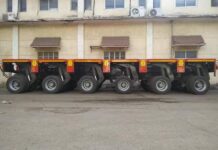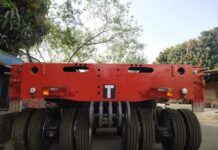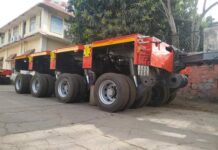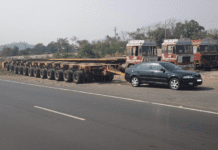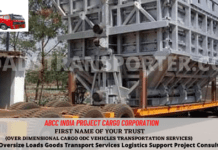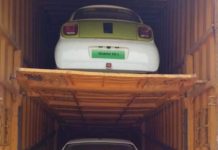The Tata 407 is a light commercial vehicle (LCV) manufactured by Tata Motors. It was first launched in India on February 21, 1986.
The invention of the Tata 407 was driven by the need for a reliable, efficient, and cost-effective LCV that could meet the diverse transportation needs of Indian businesses and communities.
Here are some key factors that led to its development:

- Growing demand for LCVs: In the mid-1980s, India’s economy was growing, and there was an increasing demand for light commercial vehicles for transporting goods and people.
- Competition: Tata Motors aimed to compete with existing players in the LCV segment, including those from Indo-Japanese joint ventures.
- Technological advancements: The Tata 407 incorporated some technological advancements for its time, such as a semi-forward cabin design for improved safety and a synchromesh gearbox for smoother shifting.
- Focus on Indian conditions: The vehicle was designed to be rugged and durable, keeping in mind the challenging road conditions and varying terrains in India.
The Tata 407 quickly gained popularity and became a bestseller in the LCV segment. Its versatility, reliability, and affordability made it a popular choice for a wide range of applications, including transporting goods, passengers, and serving as the base for various specialized vehicles.
Over the years, Tata Motors has continued to upgrade and improve the 407, introducing new models and variants to cater to evolving customer needs. Today, the Tata 407 remains an iconic and highly successful LCV in India.
Tata 407 Evolution
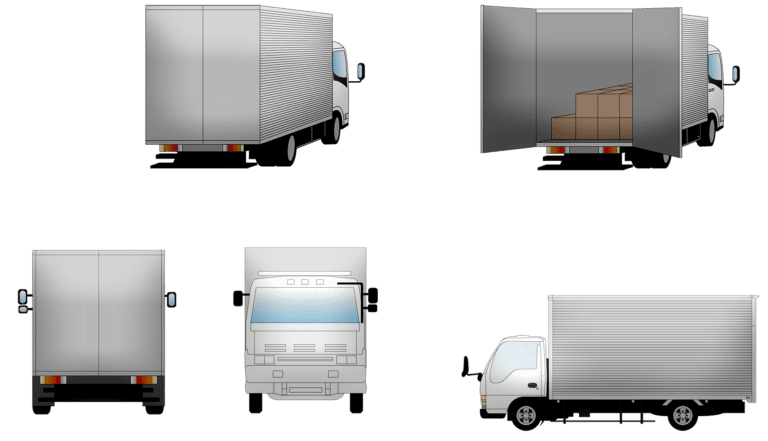
The Tata 407 has undergone significant evolution since its launch in 1986.Here’s a look at some key milestones in its journey:
Early Years (1986-1990s):
- Launch of the 407: The Tata 407 was introduced as a light commercial vehicle with a semi-forward cabin design, a 4-tonne payload capacity, and a reliable diesel engine. It quickly gained popularity due to its robustness and affordability.
- Expanding applications: The 407 found applications in various sectors, including goods transportation, passenger transport, and specialized vehicles like ambulances and school buses.
2000s and Beyond:
- Facelift and upgrades: Tata Motors introduced several upgrades and facelifts to the 407, including the EX series, which featured improved engine technology, enhanced safety features, and a more modern design.
- Introduction of variants: The 407 was offered in various configurations, including trucks, tippers, pickups, and buses, catering to diverse customer needs.
- Technological advancements: The vehicle saw the incorporation of new technologies such as CNG options for cleaner fuel, improved braking systems, and more comfortable cabins.
- Focus on emissions: Tata Motors updated the 407’s engine to comply with stricter emission norms, ensuring environmental friendliness.
- Continued market leadership: The Tata 407 has maintained its position as a market leader in the LCV segment, thanks to its reliability, durability, and continuous improvements.
Recent Developments:
- BS6 compliance: The latest iteration of the Tata 407 complies with the Bharat Stage 6 emission norms, featuring a more powerful and fuel-efficient engine.
- Enhanced features: The current models come with modern features such as power steering, a new instrument cluster, and telematics, enhancing the driving experience and operational efficiency.
- Focus on comfort and safety: Tata Motors has focused on improving driver comfort and safety by offering features like a more spacious cabin, better suspension, and enhanced braking systems.
The Tata 407’s evolution reflects its adaptability to changing market demands and technological advancements. It has consistently provided a reliable and cost-effective transportation solution for businesses and individuals in India.
Goods Carrier V/S Passenger Transportation Work
The Tata 407 is a versatile light commercial vehicle (LCV) that can be used for both goods carrier and passenger transportation. Here’s a comparison of the two applications in a chart format:
| Feature | Goods Carrier | Passenger Transportation |
|---|---|---|
| Vehicle Configuration | Typically a truck body with an open cargo area or a closed container. | Often a bus body with seating arrangements for passengers. |
| Payload Capacity | Designed to carry a significant weight of cargo, usually around 2-2.5 tons. | Focus is on the number of passengers, with varying seating capacities depending on the configuration. |
| Seating Capacity | Driver and co-driver in the cabin. | Can range from 12 to 24 passengers or more, depending on the bus body and seating layout. |
| Comfort and Amenities | Basic cabin features for the driver. | May include comfortable seating, air conditioning, entertainment systems, and other amenities depending on the class of passenger transport. |
| Safety Features | Standard safety features like brakes, lights, and seatbelts. | May include additional safety features like emergency exits, fire extinguishers, and passenger safety restraints. |
| Regulations and Permits | Requires permits for transporting goods, which may vary depending on the type of cargo and distance. | Requires permits for passenger transportation, which may include specific regulations for passenger safety and comfort. |
| Typical Use Cases | Transporting goods for businesses, delivery services, construction materials, agricultural products, etc. | School buses, staff transportation, tourist buses, public transportation within cities or towns. |
| Cost of Operation | Fuel costs, maintenance, and driver salary. | Fuel costs, maintenance, driver salary, and potentially additional costs for amenities and passenger insurance. |
Key Considerations:
- Flexibility: The Tata 407’s versatility allows it to be adapted for both goods and passenger transport, making it a popular choice for businesses with diverse needs.
- Cost-effectiveness: The 407 is known for its affordability and fuel efficiency, making it a cost-effective option for both goods and passenger transport.
- Reliability: The Tata 407 has a reputation for reliability and durability, which is important for both goods and passenger transport, where downtime can be costly.
It’s important to note that the specific configuration and features of a Tata 407 will vary depending on its intended use, whether it’s primarily for goods transport or passenger transportation.
Tata 407 Market Local V/S Global

While the Tata 407 enjoys immense popularity and a strong presence in the local Indian market, its reach and impact on the global stage are more limited. Here’s a comparison in chart form:
| Feature | Local (India) | Global |
|---|---|---|
| Market Focus | Primarily designed and marketed for the Indian market. | Limited presence in international markets. |
| Market Share | Dominant player in the Light Commercial Vehicle (LCV) segment in India. | Relatively small market share in global LCV markets. |
| Product Adaptation | Tailored to meet the specific needs and conditions of the Indian market, including varying terrains, load requirements, and fuel efficiency expectations. | May require modifications or adaptations to meet the regulations and preferences of different countries. |
| Competition | Faces competition from other domestic and international LCV manufacturers in India. | Competes with a wide range of global LCV brands, each with its own strengths and market presence. |
| Pricing | Known for its competitive pricing and affordability in the Indian market. | May face pricing challenges in international markets due to import duties, taxes, and competition. |
| Brand Recognition | Strong brand recognition and a loyal customer base in India. | Brand recognition may be lower in international markets compared to established global brands. |
| Distribution and Service Network | Extensive distribution and service network across India, ensuring easy availability of parts and maintenance. | May require establishing new distribution and service networks in international markets. |
| Regulations and Standards | Complies with Indian regulations and standards, including emission norms and safety requirements. | Must meet the specific regulations and standards of each country it enters, which can vary significantly. |
Key Takeaways:
- The Tata 407 is a highly successful LCV in India, where it has been a market leader for decades.1
- Its global presence is limited, and it primarily caters to the domestic Indian market.
- Expanding into international markets would require Tata Motors to adapt the vehicle to meet local regulations and preferences, establish distribution networks, and compete with established global brands.
While the Tata 407’s primary market remains India, its success and reputation for reliability could potentially open doors to exploring opportunities in select international markets with similar needs and conditions.
All Models
Here’s the chart with common ranges:
| Model | Length (mm) | Width (mm) | Height (mm) | Weight Capacity (kg) | Approx. Price (₹ Lakh) | Mileage (kmpl) | Annual Maint. (₹) | Resale Market |
|---|---|---|---|---|---|---|---|---|
| 407 Gold SFC 29 WB | 4687 | 1905 | 2260 | 2267 | 12-13 | 9-11 | 15,000-25,000 | Good |
| 407 Gold SFC 33 WB RJ | 5415 | 2100 | 2850 | 2500 | 11-12 | 8-10 | 18,000-30,000 | Very Good |
| 407 Gold SFC RJ | 5415 | 2100 | 2850 | 2500 | 13-15 | 8-10 | 18,000-30,000 | Excellent |
| 407 CNG (SFC) | 5020 | 1906 | 2295 | 2100 | 13-14 | 9-10 (CNG) | 20,000-35,000 | Good |
Explanation of Model Names:
- SFC: Semi-Forward Cabin (the more common, traditional look)
- WB: Wheelbase (29 WB is shorter, better for tighter spaces)
- RJ: “Reinforced” chassis, often for heavier loads
- CNG: Compressed Natural Gas variant
Advantages
The Tata 407 has earned its reputation as a reliable workhorse in India. Here’s a breakdown of its key advantages:
1. Reliability and Durability:
- Proven Track Record: The 407 has been around for decades, and its robust build quality and dependable engine have been proven in diverse Indian conditions.
- Strong Aggregates: It uses sturdy components (engine, gearbox, axles) designed for heavy-duty use and long life.
- Ruggedness: It can handle rough roads and challenging terrains, making it suitable for both urban and rural areas.
2. Cost-Effectiveness:
- Affordable Price: Compared to some other LCVs, the 407 offers a competitive price point, making it accessible to a wider range of buyers.
- Fuel Efficiency: The engine is designed to deliver decent mileage, helping to keep running costs down.
- Low Maintenance: It’s known for relatively low maintenance requirements, reducing downtime and expenses.
- High Resale Value: The 407 holds its value well in the used market, making it a good investment.
3. Versatility:
- Multiple Applications: It can be used for various purposes, including transporting goods, passengers, and serving as a base for specialized vehicles.
- Customization: The chassis can be customized with different body types to suit specific needs (truck, tipper, bus, etc.).
- Payload Capacity: It offers a good payload capacity for its class, allowing businesses to carry substantial loads.
4. Wide Availability and Service:
- Extensive Network: Tata Motors has a vast network of dealerships and service centers across India, ensuring easy access to parts and maintenance.
- Local Expertise: Mechanics and technicians are generally familiar with the 407, making repairs and servicing relatively straightforward.
5. Driver-Friendly Features:
- Comfortable Cabin: While basic, the cabin is designed to be functional and comfortable for the driver, with features like adjustable seats and power steering in some models.
- Easy to Drive: The 407 is generally considered easy to handle and maneuver, even in traffic.
6. Strong Brand Reputation:
- Trusted Name: Tata Motors is a well-known and trusted brand in India, and the 407 has benefited from this reputation.
- Customer Loyalty: Many businesses and individuals have been loyal to the 407 for its reliability and performance.
While the Tata 407 has many advantages, it’s important to consider your specific needs and compare it with other LCVs in the market before making a decision. Factors like payload capacity, engine power, features, and price should all be taken into account.
Disadvantages
While the Tata 407 has many strengths, it’s important to be aware of its potential drawbacks:
1. Basic Cabin and Features:
- Limited Comfort: Compared to some newer LCVs, the 407’s cabin can feel basic. It might lack modern amenities like advanced infotainment systems, more comfortable seating options, or extensive storage.
- Ergonomics: While functional, the cabin design might not be as ergonomically advanced as some competitors, potentially affecting driver comfort on long journeys.
2. Performance and Technology:
- Engine: While reliable, the engine might not be the most powerful or technologically advanced in its class. Some competitors offer engines with higher power output and more refined technology.
- Ride Quality: The ride quality can be somewhat bumpy, especially when the vehicle is unladen. This is typical of many LCVs, but some newer models offer better suspension and ride comfort.
3. Safety Features:
Basic Safety: The 407 typically comes with standard safety features like brakes and seatbelts. However, it might lack more advanced safety features like airbags or electronic stability control, which are becoming more common in newer LCVs.
4. Competition:
- Increasing Competition: The LCV segment is becoming increasingly competitive, with new models from other manufacturers offering more features, technology, and sometimes better performance.
- Market Share: While still a strong player, the 407’s market share might be challenged by these newer entrants.
5. Emissions:
Emissions Compliance: While the 407 now complies with BS6 emission norms, it’s important to stay updated on any future emission regulations that might require further upgrades or changes.
6. Maintenance:
Maintenance Costs: While generally low, maintenance costs can still add up over time, especially for older models. It’s important to factor in these costs when considering the total cost of ownership.
Important Considerations:
- Value for Money: Despite these potential drawbacks, the Tata 407 still offers excellent value for money, especially considering its price point, reliability, and versatility.
- Specific Needs: Whether these disadvantages are significant will depend on your specific needs and priorities. If you prioritize features and comfort, you might want to consider other options.
- Continuous Improvements: Tata Motors has been continuously upgrading the 407, so newer models might address some of these concerns.
Ultimately, the Tata 407 remains a strong contender in the LCV market, but it’s essential to weigh its advantages and disadvantages against your specific requirements and compare it with other available options before making a decision.
Here is a detailed chart outlining the best features of the Tata 407 across various models:

| Feature | Tata 407 | Description |
|---|---|---|
| Fuel Efficiency | 10 KMPL (approx) | Offers good mileage, making it cost-effective for long-distance transportation |
| Payload Capacity | 2267 kg to 3000 kg | Suitable for light to medium cargo transport, ideal for small businesses and logistics |
| Engine & Performance | 98 – 100 HP, 2956 cc Engine | Delivers a maximum torque of 300 Nm, ensuring strong performance under load |
| Safety Features | H2LS Auto Slack Adjuster, Parking Brakes | Offers reliable braking, advanced suspension, and safety features like auto slack adjusters for better control |
| Ground Clearance | 209 mm | High clearance makes it suitable for rural and rough terrains, ensuring smoother drives |
| Cabin Design | Ergonomic Driver Cabin | Spacious cabin with a comfortable seat for long journeys, with manual steering for better control |
| Technology & Emissions | BS6 Phase 2, Eco-Friendly | Complies with BS6 Phase 2 emission standards, offering better fuel efficiency and reduced environmental impact |
| Turning Radius | 11,900 mm (approx) | Excellent maneuverability in tight spaces, making it easier to navigate congested urban areas |
| Durability | Ladder-Type Chassis, Sturdy Build | Built with high-strength materials, the Tata 407 ensures durability and reliability, especially in challenging conditions |
| Service & Maintenance | Widespread Network, Low Maintenance Cost | Tata offers a strong network of service centers and affordable maintenance, reducing overall operational costs |
Tata 407 for Single Owners (Small Businesses)
| Aspect | Single Owner (Small Business) |
|---|---|
| Use Case | Ideal for local transport, small-scale deliveries, and rural operations. Often used for retail, groceries, and small cargo. |
| Cost Efficiency | Moderate initial cost ( |
| Flexibility | Flexible for daily operations; often used for door-to-door deliveries in urban and semi-urban areas. |
| Manoeuvrability | Easier to drive in narrow lanes and congested areas due to a smaller size and better turning radius (11,900 mm). |
| Maintenance | Lower maintenance costs due to simple design and widespread service network. Cost-effective for small businesses. |
| Resale Value | Retains decent resale value, ideal for upgrading when business expands. |
| Capital Investment | A one-time investment with a manageable loan option but can be a heavy burden if the business grows. |
| Ownership Experience | Owner is responsible for management and daily operations, which gives a personal connection to the vehicle. |
Tata 407 for Big Logistic Companies & Transporters
| Aspect | Big Logistic Companies / Transporters |
|---|---|
| Use Case | Heavy-duty transport for bulk goods across regions; used in freight and long-distance logistics. |
| Cost Efficiency | The cost per unit is spread across multiple trucks; however, operational costs are significant due to the fleet size. Lower fuel efficiency (10 KMPL). |
| Fleet Management | Requires advanced fleet management systems to track and monitor operations, including scheduled maintenance and driver management. |
| Customizations | Can be modified for specialized transport needs (e.g., refrigerated, high-load configurations). |
| Profitability | Utilized for high-volume and frequent operations, making it a consistent income generator. |
| Maintenance | Regular maintenance required for a fleet. Costs are higher but managed with bulk servicing and maintenance contracts. |
| Resale Value | Resale value per truck is lower, but the fleet’s resale contributes to overall return on investment. |
| Operational Scale | Efficient for large-scale operations but requires additional logistics planning and coordination. |
Summary
- Single owners benefit from Tata 407 due to its affordability, low maintenance cost, and ease of use for local deliveries and small businesses. However, the capital investment might be significant, and the business may struggle to scale rapidly without expanding its fleet.
- Big logistic companies/transporters use Tata 407 in large quantities to manage bulk transport. While the operational cost and maintenance become higher, the scalable operations and fleet management ensure consistent returns. They also benefit from customization options and better resale value when selling in bulk.
Tata 407 Safety Features With Accident Rescues
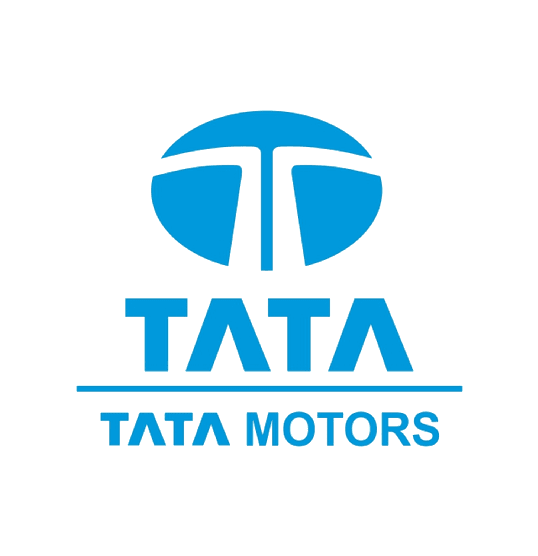
Here is a chart highlighting the safety features of the Tata 407, along with how these features contribute to accident rescue:
| Safety Feature | Description | Accident Rescue Impact |
|---|---|---|
| Power Steering | Offers easier handling and precise control, reducing driver fatigue. | Better control in emergency situations, reducing the risk of accidents. Easier to maneuver in tight spaces. |
| Vacuum Assisted Braking System (H2LS) | Advanced braking system for better grip and stopping power. | Provides quick response in sudden stops, reducing the severity of accidents and aiding in collision avoidance. |
| Parking Brakes | Ensures the vehicle is stationary when parked, preventing rolling. | Helps prevent vehicle movement after an accident, especially on inclines, keeping the vehicle from causing additional harm. |
| Cabin Design | Ergonomically designed cabin with a stronger frame for driver protection. | In case of a frontal collision, the cabin’s design minimizes injury risk to the driver by absorbing impact force. |
| Crashworthy Structure | Strong, crash-resistant body with reinforced pillars. | Reduces the risk of cabin collapse in the event of a crash, ensuring driver and passenger safety. |
| High Ground Clearance | 209 mm ground clearance to avoid undercarriage damage. | Helps minimize undercarriage damage in off-road accidents, especially in rural areas, improving overall rescue efforts. |
| Manual Transmission | Standard 5-speed manual transmission for precise control. | Allows quick gear shifts in emergency situations, helping drivers regain control post-accident to avoid further hazards. |
| Advanced Suspension System | Durable suspension system to handle heavy loads and rough roads. | Reduces vehicle instability in rough conditions, which can prevent accidents on poor roads. |
| Side Impact Protection | Reinforced side panels to protect from side collisions. | Minimizes injury risk in side-impact accidents, offering better protection during T-bone or side crashes. |
| Anti-Roll Bar | Reduces vehicle roll during sharp turns or when laden with cargo. | Reduces the chances of vehicle flipping over in sudden movements, helping to prevent rollovers. |
Accident Rescue & Safety Impact
- Power steering and advanced braking systems help the driver maintain better control, reducing accidents.
- The crashworthy structure and reinforced cabin design are critical in case of a crash, ensuring that the driver is protected from severe injury.
- Side impact protection and the manual transmission offer quick driver responses, allowing swift action during accidents.
- Ground clearance and advanced suspension systems help the vehicle withstand rough terrain impacts, ensuring better maneuverability in tough environments, which can be vital for rescue operations.
Tata 407 Resale Market India Local and Global

Here is a detailed chart showing the resale value of the Tata 407 in both local and global markets:
| Market | Model | Resale Value (₹) | Key Factors |
|---|---|---|---|
| India (Local) | Tata 407 (Standard) | ₹6 Lakh – ₹8 Lakh | Retains strong demand in urban & rural areas due to high utility. |
| Tata 407 Gold SFC | ₹7 Lakh – ₹10 Lakh | Preferred by businesses for small transport, holds better value over time. | |
| Tata 407 Gold SFC 29 WB | ₹8 Lakh – ₹11 Lakh | Larger fleet use and modern features increase resale value. | |
| India (Used Market) | Tata 407 (older models) | ₹3 Lakh – ₹5 Lakh | Slight depreciation but still valuable in secondary markets. |
| Global Market | Tata 407 (Exports) | ₹5,000 – ₹8,000 (USD) | Resale value is lower due to import duties, but still preferred in select countries. |
| Tata 407 Gold SFC | ₹7,000 – ₹10,000 (USD) | Higher demand in countries with limited local commercial vehicle options. | |
| Key International Regions | Africa, Middle East, Southeast Asia | Prices depend on age, condition, and region | The vehicle is used widely in transport, offering strong secondary market value in these regions. |
Key Insights:
- Strong Resale in India: The Tata 407 retains good resale value in India, with the Gold SFC models holding the highest resale potential, particularly if kept in good condition.
- Global Resale Value: In global markets, especially in regions like Africa, Middle East, and Southeast Asia, the resale market for Tata 407 is moderate. The price is lower due to import duties and the vehicle’s older designs, but still a preferred choice due to its reliability and utility.
- Depreciation Over Time: Like many commercial vehicles, older Tata 407 models depreciate faster. However, even older models still have significant demand in the used vehicle market due to their reliability and affordability in the second-hand market.
Here’s a fact about the Tata 407 that often surprises people:

The Tata 407’s design has roots in a German truck from the 1960s!
It’s true! Tata Motors actually purchased the tooling and design rights from Steyr, an Austrian company, back in the 1980s. Steyr’s 591/691 series of trucks, which themselves were derived from the Hanomag F-series from the 1960s, formed the basis for the Tata 407’s iconic look.
What does this mean?
- Heritage: The 407’s basic shape and cabin design have a surprisingly long lineage, going back decades to a German commercial vehicle design.
- Adaptation: Tata Motors took this design and heavily adapted it for Indian conditions, making it more rugged and suitable for the demands of the local market.
- Simplicity: The 407’s relatively basic design, with its focus on functionality over frills, is partly a result of its older origins. This simplicity contributes to its reliability and ease of maintenance.
It’s a testament to how a well-designed vehicle can endure and evolve! The Tata 407 took a design from decades past and made it its own, becoming a legend in the Indian commercial vehicle market.
TATA 407 Contribution TATA MOTORS Growth
The Tata 407 has been a significant contributor to Tata Motors’ growth and success in the Indian commercial vehicle market. Here’s a breakdown of its contributions:
1. Market Leadership:
- Dominant Player: The Tata 407 has been a market leader in the Light Commercial Vehicle (LCV) segment in India for decades. Its popularity and strong sales have contributed significantly to Tata Motors’ overall market share and revenue.
- Brand Recognition: The 407’s success has helped build and reinforce Tata Motors’ brand recognition and reputation for producing reliable and affordable commercial vehicles.
2. Versatility and Wide Applications:
- Adaptability: The 407’s versatility, with its ability to be configured as a truck, tipper, bus, or other specialized vehicles, has allowed Tata Motors to cater to a wide range of customer needs and applications. This has broadened its customer base and market reach.
- Addressing Diverse Needs: The 407 has served various sectors, including transportation, logistics, agriculture, construction, and even passenger transport, making it a valuable asset for businesses and individuals across India.
3. Cost-Effectiveness and Profitability:
- Affordable and Fuel-Efficient: The 407’s competitive pricing and fuel efficiency have made it an attractive option for cost-conscious businesses and individuals. This has contributed to its strong sales and profitability for Tata Motors.
- Low Maintenance: The 407’s relatively low maintenance requirements have further enhanced its cost-effectiveness, making it a popular choice for small businesses and owner-operators.
4. Customer Loyalty and Trust:
- Reliable Workhorse: The 407’s reputation for reliability and durability has fostered customer loyalty and trust in the Tata Motors brand. This has led to repeat business and positive word-of-mouth marketing.
- Meeting Expectations: The 407 has consistently met the expectations of its customers, providing a dependable and affordable transportation solution for their businesses and livelihoods.
5. Legacy and Continuous Improvement:
- Enduring Legacy: The 407 has built a strong legacy over decades, becoming an iconic and trusted commercial vehicle in India. This legacy has contributed to Tata Motors’ long-term success and brand image.
- Evolution and Upgrades: Tata Motors has continued to invest in the 407, introducing new models, upgrades, and variants to keep it relevant and competitive in the market. This commitment to continuous improvement has further strengthened its position and appeal.
In summary, the Tata 407 has been a cornerstone of Tata Motors’ growth in the Indian commercial vehicle market. Its versatility, affordability, reliability, and strong customer base have contributed significantly to the company’s market leadership, brand recognition, and profitability.
Investing in a Tata 407 for earning income can be a profitable venture, particularly for a common man looking to start a small business or fleet operation. Below is a chart outlining potential income generation methods and estimated earnings:
Ways to Earn Money with Tata 407
| Method | Description | Estimated Monthly Income (₹) | Annual Income (₹) |
|---|---|---|---|
| 1. Parcel/Logistics Transport | Transport goods for local businesses or e-commerce companies. You can tie-up with companies like Amazon, Flipkart, or local distributors. | ₹30,000 – ₹50,000 (for local routes) | ₹3,60,000 – ₹6,00,000 |
| 2. Rental Services | Rent the Tata 407 to other transporters or businesses that require a vehicle on lease. | ₹25,000 – ₹40,000 (depending on location and duration) | ₹3,00,000 – ₹4,80,000 |
| 3. Construction/Material Transport | Transport building materials like sand, cement, bricks, and stones for construction projects. | ₹40,000 – ₹70,000 (if working regularly with construction firms) | ₹4,80,000 – ₹8,40,000 |
| 4. Agricultural Transport | Use the Tata 407 to transport agricultural goods (fruits, vegetables, grains) to wholesale markets. | ₹30,000 – ₹45,000 | ₹3,60,000 – ₹5,40,000 |
| 5. Passenger Transport | Use the Tata 407 for shared transportation for school, workers, or travel tours. | ₹25,000 – ₹40,000 | ₹3,00,000 – ₹4,80,000 |
| 6. Moving Services | Provide moving services for households, businesses, or offices. | ₹30,000 – ₹60,000 (depending on demand) | ₹3,60,000 – ₹7,20,000 |
| 7. Packaging and Delivery | Transport packaging materials and deliver goods to small shops or individuals. | ₹25,000 – ₹45,000 | ₹3,00,000 – ₹5,40,000 |
Key Considerations
- Fuel Costs: A Tata 407 typically gives 10 KMPL mileage, and fuel costs can vary based on distance and local fuel rates. Expect ₹15,000 – ₹20,000 monthly in fuel costs for an average business.
- Maintenance Costs: Maintenance for the Tata 407 can cost ₹30,000 – ₹50,000 annually, and regular upkeep may add up to ₹2,500 – ₹4,000 monthly.
- Partnership Opportunities: Partnering with logistics companies, construction firms, and e-commerce giants can help ensure steady work and income flow.
Overall Income Potential
A common man investing in a Tata 407 could potentially earn ₹30,000 to ₹70,000 per month, translating to ₹3,60,000 to ₹8,40,000 annually, depending on the type of work and utilization of the vehicle.
Summary and Conclusion
The Tata 407 is a versatile, reliable, and affordable light commercial vehicle (LCV) that has played a vital role in India’s transportation and logistics sector for decades. Its adaptability, fuel efficiency, and ease of maintenance have made it a popular choice for businesses and individuals across the country.
The 407 has contributed significantly to Tata Motors’ growth and market leadership in the Indian commercial vehicle industry. Its popularity has created a strong brand reputation and fostered customer loyalty. The 407’s versatility allows it to cater to various applications, including goods transportation, passenger transport, and specialized vehicles.
While the Tata 407 has some limitations, such as its basic cabin and lack of advanced safety features, its overall value proposition remains strong, especially considering its affordability and low operating costs.
In conclusion, the Tata 407 is a dependable and adaptable workhorse that continues to serve the needs of businesses and individuals across India. Its enduring legacy and continuous evolution are a testament to its importance in the Indian automotive landscape.
What is the Tata 407?
The Tata 407 is a popular light commercial vehicle (LCV) from Tata Motors, widely used for transportation of goods and passengers. It is known for its durability, efficiency, and low maintenance costs.
What is the payload capacity of the Tata 407?
The Tata 407 has a payload capacity of up to 2.5 to 3 tons, depending on the variant and specific configuration.
What engine is used in the Tata 407?
The Tata 407 is equipped with a 3.0-liter, 4-cylinder, BS6-compliant diesel engine that delivers a power output of around 85 HP (horsepower) and a torque of approximately 250 Nm.
What are the key features of the Tata 407?
Some key features of the Tata 407 include:
Robust engine for better performance.
Spacious and comfortable cabin.
Advanced suspension for better handling.
Power steering for easy maneuvering.
Efficient fuel consumption.
What are the fuel efficiency figures of the Tata 407?
The Tata 407 offers an average fuel efficiency of around 10-12 km per liter, depending on load, road conditions, and driving habits.
What is the price range of the Tata 407?
The price of the Tata 407 typically ranges between INR 8-11 lakhs, depending on the specific model and region. Prices may vary based on dealer and location.
What variants are available for the Tata 407?
The Tata 407 comes in different variants, including:
Tata 407 Gold SFC
Tata 407 EX
Tata 407 4WD (4-Wheel Drive) Each variant is suited for specific cargo and transportation needs.
Is the Tata 407 available in 4WD?
Yes, the Tata 407 is available in a 4WD (Four-Wheel Drive) version for enhanced off-road capabilities, which is particularly useful in rural or rough terrains.
What is the warranty on the Tata 407?
The Tata 407 typically comes with a 2-year or 100,000 km warranty, whichever comes first. This warranty covers major defects and issues related to manufacturing.
What are the safety features of the Tata 407?
The Tata 407 is equipped with safety features like:
Front disc and rear drum brakes.
Optional driver airbag.
Strong steel body for crash protection.
Anti-lock Braking System (ABS) in some variants.
Can the Tata 407 be used for passenger transport?
Yes, the Tata 407 is commonly used as a passenger carrier in mini-bus configurations. The cabin can be modified for seating, making it ideal for transporting small groups of passengers.
How is the after-sales service for the Tata 407?
Tata Motors provides a strong after-sales network with authorized service centers across India. The Tata 407 is known for low maintenance costs, and spare parts are widely available.
How often should the Tata 407 be serviced?
It is recommended to service the Tata 407 every 10,000 to 12,000 kilometers or as per the service manual, to ensure optimal performance and longevity of the vehicle.
Does Tata offer finance options for the Tata 407?
Yes, Tata Motors provides finance options through various banks and financial institutions. You can avail loans for the purchase of Tata 407 with attractive EMIs and flexible repayment terms.
What are the color options available for the Tata 407?
The Tata 407 is available in various colors including white, red, yellow, and green, depending on the specific model and variant.
TATA 407 Available in EV Segment ?
Yes, the Tata 407 is available as an EV. Tata Motors has partnered with several companies to create electric versions of the 407. These are not factory-built EVs in the traditional sense. Instead, they involve retrofitting existing Tata 407 diesel trucks with electric powertrains.
Here are some key points about the Tata 407 EV:
Partnerships: Tata Motors has collaborated with companies specializing in EV technology to develop these electric conversions.
Retrofitting: The process involves taking a standard Tata 407 diesel truck and replacing its engine, transmission, and other components with an electric motor, battery pack, and related systems.
Range and Charging: The range of the Tata 407 EV varies depending on the specific conversion kit and battery capacity but is generally suitable for urban and regional transportation needs. Charging times also vary but often include options for both fast charging and overnight charging.
Benefits: The Tata 407 EV offers environmental benefits due to zero tailpipe emissions, as well as potential cost savings in fuel and maintenance compared to a diesel-powered 407.
If you’re interested in learning more about the Tata 407 EV, I recommend contacting Tata Motors or exploring resources about electric vehicle conversions in India.

